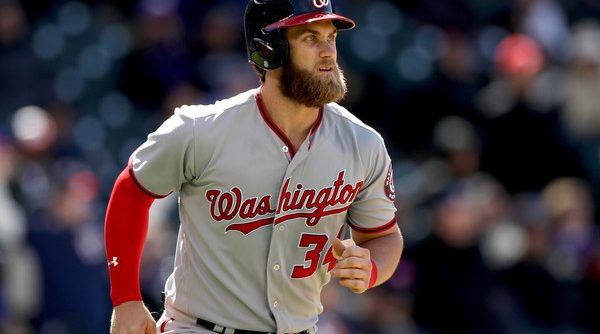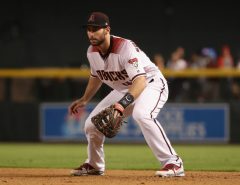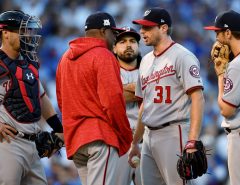I believe the Nats should re-sign Bryce Harper, and they should do it as soon as possible.
Will it take $400 million?
At least that. Probably more.
But they should do it anyway.
Is he worth it? Can the Nats afford it? Why now?
Yes, he’s worth it
The Nationals haven’t been shy about paying (and at times overpaying) for quality players when they think they’re worth it. Jayson Werth, Ryan Zimmerman, Max Scherzer, and Stephen Strasburg have all received $100M+ contracts from the Lerners and Mike Rizzo. But none are worth as much as Harper. Big dollar contracts are risky. Players get worse as they get older. They get hurt. Often it’s a combination of the two. Harper will be the rare free agent selling his prime years instead of cashing in after the fact. Harper’s best years are ahead of him. He’s going to get paid. It’s just of question of who gets him.
He was a 22-year-old unanimous MVP and has a 9 WAR season under his belt. He’ll be 26 in the first year of his free agent contract. The start of 2017 is showing that Bryce hasn’t lost his MVP form as Liz lays out. Granted, 2016 is a reminder that injury can sap even the greatest of hitters. So, with a ceiling of 9.5 WAR and a floor of 1.7, is Harper really worth $40M a year for the next decade?
Yep.
Currently, $8M in salary equals 1 WAR. So, a 5-win player is worth $40M a year in salary. Of course, nobody is paid that. Yet. To pay that over 10 years – the probable length of Harper’s contract – seems nuts. But if somebody’s going to do it, and somebody is going to do it, then you do it on someone like Harper.
Most players that get $20M+/year contracts are in their late 20s with their contract covering the last of their prime and the beginning of their decline. A ten-year deal for Harper would run out in his mid-30s. The players that are most likely to carry value into their 30s are power hitters like Harper. Speed goes first, then defense. But power and the batting eye hang around. David Ortiz averaged just over 4 wins a year for his career in Boston—his age 28 through age 40 seasons—including 4.4 wins last year.
Ortiz never had a season over 7 wins. Harper already does, and could be on his way to another. Plus, Harper doesn’t need to average 5 wins a year for the entire length of the contract. Inflation means the price of a win will go up. It’s increased from $6M/WAR in 2014. Perhaps it levels off at some point, but money will be worth less in the future. It’s why the Lerners defer players’ salaries as though they’re pirates burying treasure. The $7M they will be paying Max after he’s done playing will be worth less than the $7M they’re paying him now.
Dave Cameron of Fangraphs.com pointed to inflation back in early 2016 as one of the reasons he thinks it could take as much as $500 million to sign Harper. There are truly only two contracts that compare to Harper’s next deal: Giancarlo Stanton’s 13-year, $325M deal in 2015, and Alex Rodriguez’s 10-year, $252M deal in 2000. Cameron shows that Harper’s numbers are similar to ARod’s at the time of Rodriguez’s first contract. $25.2M in 2000 represented twelve times the average MLB salary. In today’s numbers that would be $48M/year for Harper to match it. I don’t think he’ll get that, but I think he’ll come closer to ARod’s $48M/year than Stanton’s $25M/year.
Every week that goes by with Harper looking like the 2015 MVP will help persuade teams that the Harper of the future will be closer to his ceiling than his floor. So, somebody’s going to pay him. Ultimately, what he can get on the open market is what he’s worth.
Yes, the Lerners can afford it
The Yankees are most often mentioned as the team ready and willing to spend on Harper due to their unlimited payroll and high-salary deals coming off the books. But I believe the Nats can and should match them. The Nats are big market team. They don’t get revenue sharing due to their market size. They’ve spent like the top tier market that they are, too. While the team’s spending habits seem inconsistent (if not irrational), they have shown a willingness to be top-ten in payroll.
If they lose Harper, my bet is they’d end up paying someone else close to $25M/year to replace him, be it in the outfield or somewhere else in the lineup. Then they’d have to do it again at the halfway point of Harper’s future deal, to replace the replacement. That contract would most likely pay in upwards of $30M/year for a top-flight player in the late 2020s. So, paying Harper between $40-45M/year for the next decade would *only* be $20M/year more (give or take five million) than they’ll end up paying a lesser player, who would carry similar risks of injury and decline.
Finding an extra 20 million or so in the couch cushions each year for the next 10 years isn’t as hard as you might think if you’re a billionaire (as Ted Lerner is), or if you’re owed millions for your TV rights (as Ted Lerner is). The Nats are claiming that the O’s currently owe the Nats $298 million in fees from 2012-16 seasons. And they’re asking for at least an additional $25M/year in rights moving forward. The Nats have claimed in legal documents that the lack of payment of these fees has hurt their pursuit of free agents, which leads one to believe they would have spent more if they could have.
Despite the usual slow pace of these negotiations, there are new hearings on the books for this year that could hopefully end this dispute and get the Nationals paid. The difference in what they’ve been paid by the Orioles and MASN versus what they should be paid is almost exactly the amount of extra money they’ll need to keep Harper in Washington through his mid-30s. The Nats need to get the MASN deal worked out before the winter of 2018. Then we’ll all know how much they really have to spend, dare they cry cheap. Worst case scenario, the billionaire owner floats his beloved team a few tens of millions of dollars until the deal is resolved, at which point the back pay would more than compensate his loan.
If Nats want more money for the TV rights then they need players people want to watch. Harper’s off-the-field celebrity is unmatched by any other DC sports figure and figures only to grow with his success on the field. Every player carries injury risks, but not every player carries the upside of Harper. While the Nats have some interesting outfield prospects in the pipeline, a prime Harper can be better than two other big-money free agents. Cameron used Jason Heyward and Justin Upton as examples of two guys who cost as much combined as Harper could, yet underperformed Harper’s 2015 season.
Yes, they should do the deal now
Most players that are extended are extended before the last year of their contract, which would be this winter for Harper. Stanton signed before he became a free agent. He got 13 years, but he only got $25M/year instead of the $30Mish he might have gotten for fewer years if he’d have waited. Thus, if there’s any hope for a hometown discount then it would happen sooner than later.
Harper’s due two more years of historically high arbitration salaries, so the two parties will be talking money soon. That said, Scott Boras took Stephen Strasburg into his last season before working out an extension and has a history of advising his clients to test the market. I expect Bryce will hit the open market, considering the historic nature of his earning potential. But that shouldn’t stop the team from trying to lock him up as soon as they can.
If they can’t, then they will have to outbid the Yankees, and anybody else with half billion to spend, to keep Harper two winters from now. But even then, he’s worth it and the Lerners can afford it. Bryce Harper has a chance to stamp his name on this team and on this city in a way he can never do in New York. I think Bryce knows that. So, if he’s worth the money, the owners have the money, and he has an inclination to stay, then I see no reason why shouldn’t wear the Curly W for the rest of his career.
We’re going to need a reason to watch MASN, after all.
Tags: Alex Rodriguez, Bryce Harper, Giancarlo Stanton, MASN, Mike Rizzo, Nationals, Nats, Scott Boras, Stephen Strasburg, Ted Lerner, Washington Nationals





Leave a Reply